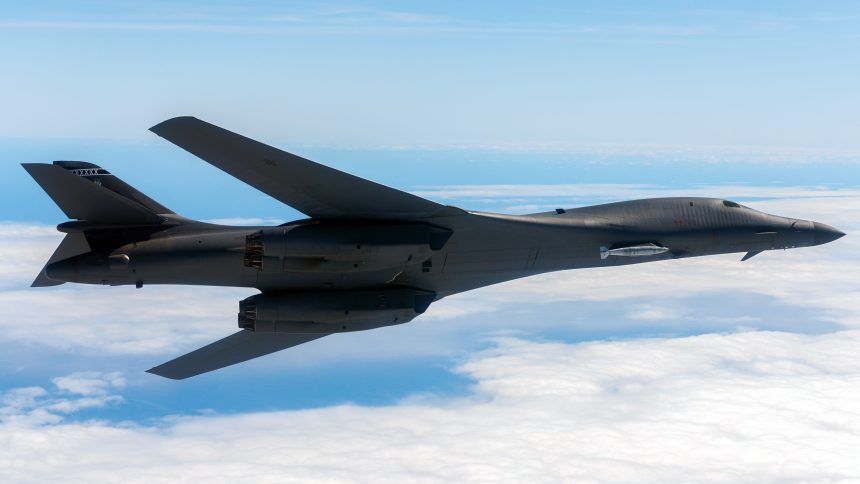The Rockwell B-1 Lancer is a supersonic variable-sweep wing strategic bomber developed by Rockwell International and operated by the United States Air Force (USAF). Alongside its subsonic stablemates, the B-2 Spirit stealth bomber and the massive B-52 Stratofortress.
Officially named the “Lancer”, but affectionately known as BONE from the spelling of its B-1 designation (“B-one”), the Rockwell B-1 Lancer was initially developed as the B-1A, a highly supersonic nuclear-delivery aircraft. Capable of exceeding Mach 2, the B-1A featured variable-sweep wings and advanced avionics for low-level penetration. However, it only entered service as the B-1B, a variant of the B-1A, with reduced top speed but improved survivability and conventional payload capabilities. The B-1B entered operational service in 1986 during the final years of the Cold War.
After the collapse of the Soviet Union, the B-1B fleet underwent a refit to improve its conventional capabilities, until the limitations of the New START arms-control treaty with Russia completely removed the bomber’s ability to deliver nuclear weapons, relegating it to a conventional strike role, a position in which it excelled thanks to its 75,000-pound (34,000 kg) payload, the heaviest among the current U.S. strategic bombers. This marked the full transition of the B-1B from a dual-capable bomber to a platform focused solely on delivering conventional payloads.
In this newfound capacity, in which the BONE is still serving, the bomber participated in numerous operations worldwide, starting with the 1998 strikes over Iraq, up to the recent February 2024 attacks against Iranian-backed terrorist militias in Syria and Iraq.
The Rockwell B-1 Lancer was originally developed by Rockwell International. After the program was revived in the 1980s to develop the B-1B variant, Rockwell continued as the primary contractor. The B-1B is a variant of the B-1A, featuring significant upgrades in avionics, radar cross-section reduction, and electronic warfare systems. In 1996, Boeing acquired Rockwell’s aerospace and defense divisions, which included the B-1 program. So, while Rockwell was the original designer and manufacturer of the B-1, Boeing took over its maintenance, support, and future modifications.
Out of the 104 airframes produced, 45 are still in service with the United States Air Force (USAF), but the expected introduction in 2025 of the new stealth Northrop-Grumman B-21 bomberz, part of the LRS-B (Long Range Strike Bomber) program and expected to enter service in 2025 is expected to signal the beginning of the end of the long BONE career, with the last Lancer being retired in 2036.
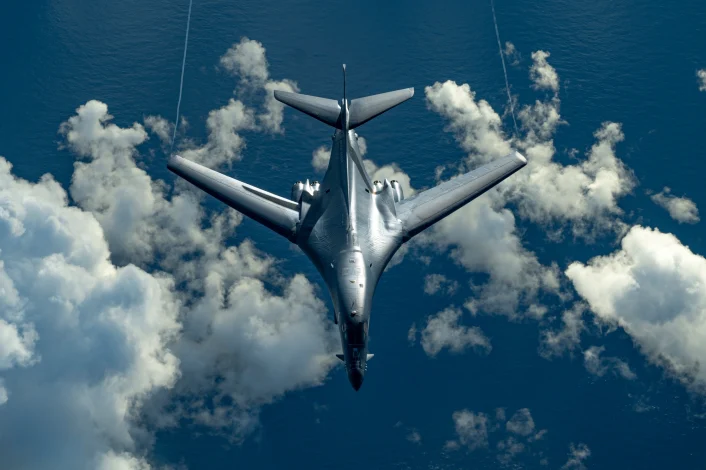
About the Rockwell B-1 Lancer
The B-1 owes its existence indirectly to the shooting down over the Soviet Union of the U-2 spy plane piloted by Francis Gary Powers. That incident made apparent that the era of high-altitude bomber raids was over, killed by the advancement of Surface-to-Air Missiles and prompting the cancellation in 1961 of the Mach 3-capable XB-70 Valkyrie bomber. This started a lengthy study for a new bomber capable of low altitude penetration of enemy airspace and supersonic speeds, similar to the F-111 Aardvark but with greater payload and range.
The project, however, had to contend for financing with the coming of age of Intercontinental Ballistic Missiles (and even more so with Submarine-launched Missiles), which threatened to take the nuclear strike role away from bombers.

In 1969, the lengthy AMSA project finally morphed into the B-1A, with North American Rockwell (then Rockwell and currently part of Boeing) being awarded the contract for the expected 240 new bombers.
In common with other penetrating strike aircraft of the period, like the American F-111 Aardvark, the European Panavia Tornado and the Soviet Su-24 Fencer, the design featured variable-sweep wings in order to provide both more lift during takeoff and landing (requiring shorter runways and being able to operate from more airbases), and lower drag during high-speed flight.
Exhaust nozzles and air intake ramps were variable to achieve the expected Mach 2 performance at high altitudes (a B-1A reached a top speed of Mach 2.22 during trials). These features later helped define the B-1 bomber’s top speed record during developmental testing.
The first B-1A prototype flew on Dec. 23, 1977, but news of the coming Soviet MiG-31 interceptor equipped with a look-down/shoot-down radar, coupled with advancing work on a stealth bomber (the B-2) and rising costs, prompted President Carter to cancel the program in 1979.
The need to face a Soviet escalation of Cold War proxy wars in Angola, Afghanistan and all over the world, however, prompted President Reagan in 1981 to reinstate the project, albeit in a modified version, the B-1B.
The new airplane featured a lower top speed and fixed intake ramps, lowering cost and radar cross section, but increasing maximum takeoff weight and upgraded electronic warfare capabilities.
The first B-1B was completed in 1983, while the 100th and final B-1B was delivered in 1988.
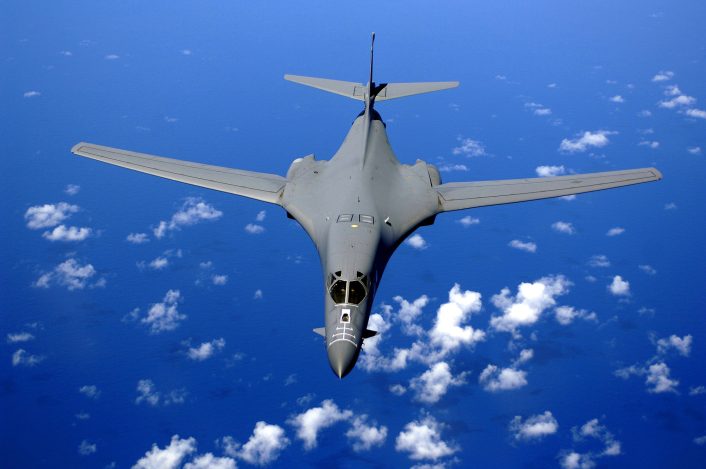
After the collapse of the Soviet Union and the signing of the New START arms-control treaty with Russia, the BONE underwent a refit that completely removed its ability to deliver nuclear weapons, relegating it to a conventional strike role.
Its 75,000-pound (34,000 kg) payload, the heaviest among current U.S. bombers, has been employed since 1998 in Iraq. The Lancer was then deployed again against Iraq in 2003, during the war in Afghanistan and the 2011 Operation Odyssey Dawn in Libya. The most recent attack was in 2024, when B-1B struck targets in Syria and Iraq.
The B-1B is expected to be replaced by the B-21 stealth bomber, and the last Lancers, whose divestment started in 2021, should serve until 2036. The work required to prepare some of the airbases to the B-21 Raider had an impact on the Lancer units too: for instance, the 28th Bomb Wing from Ellsworth Air Force Base, South Dakota, with the help of the 319th Reconnaissance Squadron, performed the B-1B Lancer bomber’s first hot-pit refueling in 30 years at Grand Forks AFB, North Dakota, on Oct. 1, 2024. Grand Forks was previously a B-1B base until the bombers were relocated in 1994. The training event tested the base and its Airmen’s adaptability in the backdrop of Ellsworth’s B-1B Lancer fleet, possibly temporarily relocating to Grand Forks AFB due to a runway construction project at Ellsworth AFB in preparation for the arrival of the B-21.
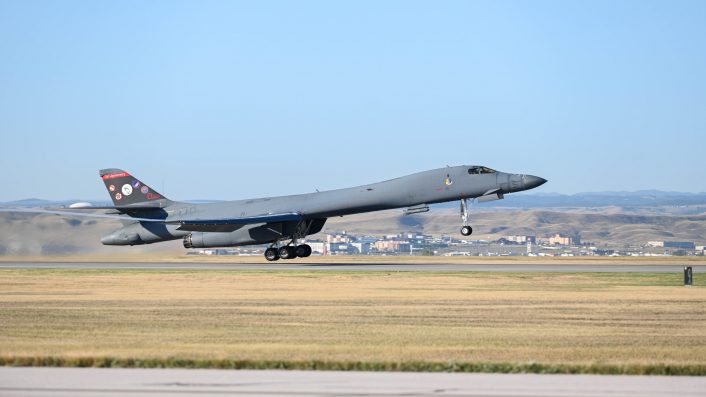
B-1 Lancer: Variants
B-1A
The original B-1 design, produced in 4 airframes with variable engine intakes and a maximum speed of Mach 2.22.
B-1B
The revised 1983 design, with fixed intakes, a maximum speed of Mach 1.25 and a reduced radar signature, was produced in 100 airframes.
B-1R
A proposed 2004 upgrade for the B-1B, with modern AESA radars, the capability to carry air-to-air missiles (performing the “missileer” role similar to the new F-15EX), the F119 engines of the F-22 Raptor and a maximum speed of Mach 2.2.
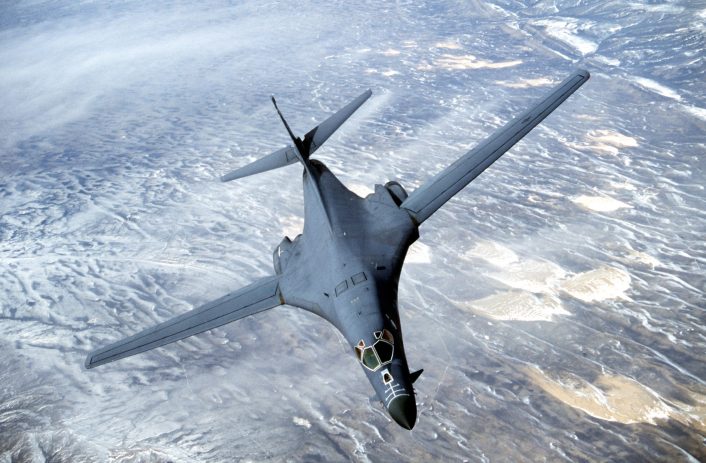
B-1 Lancer: Operators
The B-1B has only been in service with the United States Air Force, first with the Strategic Air Command, then from 1992 until 2015 with the Air Combat Command, and since then with the Air Force Global Strike Command.
The USAF currently has 45 B-1B airframes.
They are operated by:
- 9th Bomb Squadron and the 28th Bomb Squadron of the 7th Bomb Wing from Dyess AFB, Texas;
- 34th Bomb Squadron and the 37th Bomb Squadron of the 28th Bomb Wing from Ellsworth AFB, South Dakota;
- 337th Test and Evaluation Squadron from Dyess AFB, Texas (part of the 53d Test and Evaluation Group from Nellis AFB, Nevada);
- 77th Weapons Squadron from Dyess AFB, Texas (part of the 57th Wing from Nellis AFB, Nevada);
- 412th Test Wing of the Air Force Flight Test Center of Edwards AFB, California.
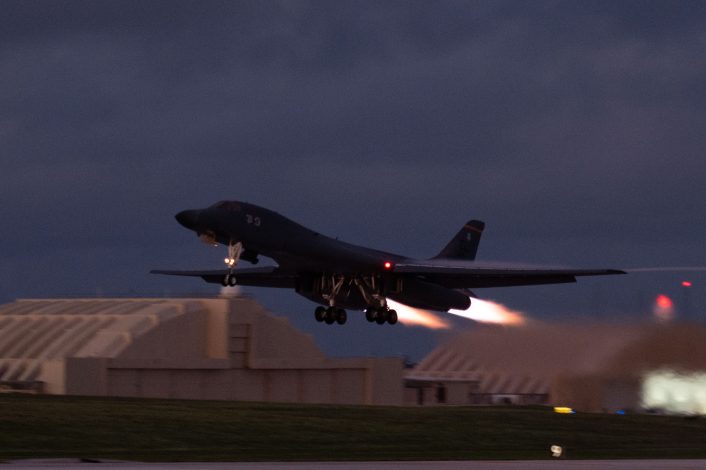
Out of 17, the U.S. Air Force retired and stored at the 309th Aerospace Maintenance and Regeneration Group (AMARG) at Davis-Monthan AFB, Arizona, four were maintained “in a reclaimable condition” so that they could be regenerated if needed. One of the four was elected to be regenerated from the “Boneyard” at Davis-Monthan AFB, Arizona to replace the B-1B Lancer bomber of the 7th Bomb Wing, serial 85-0089, which experienced a fire engine failure during routine maintenance at Dyess Air Force Base, Texas, on April 20, 2022. The projected repair costs to fix the fire-damaged aircraft were expected to be cost-prohibitive; therefore, the U.S. Air Force decided to pull one of the retired Lancers from storage at AMARG and recall it back to duty to bring the BONE fleet back to 45 total Lancers.
Rockwell B-1 Lancer: Specifications
General Characteristics
- Crew: 4 (Aircraft Commander, Pilot, Offensive Systems Officer, Defensive Systems Officer)
- Length: 146 ft (45 m)
- Wingspan: 137 ft (42 m), 79 ft (24 m) swept
- Height: 34 ft (10 m)
- Empty weight: 192,000 lb (87,090 kg)
- Gross weight: 326,000 lb (147,871 kg)
- Fuel capacity: 265,274 lbs (120,326 kg)
- Payload: 75,000 lbs (34,019 kg) internal, 50,000 lbs (22,679 kg) external
- Max takeoff weight: 477,000 lb (216,364 kg)
- Powerplant: Four General Electric F101-GE-102 afterburning turbofan engines, 17,390 lbf (77.4 kN) thrust each, 30,780 lbf (136.9 kN) with afterburner.
Performance
– Maximum speed: Mach 1.25
– Range: 5,100 nmi (9,400 km) with 37,000 lb (16,800 kg) payload
– Maximum range: 6,500 nmi (12,000 km)
– Service ceiling: 60,000 ft (18,000 m)
Armament
Three internal bomb bays for 75,000 lbs (34,019 kg) of ordnance. Six external hardpoints with a capacity of 50,000 lbs (23,000 kg), with the new LAM pylons expected to be able to carry 7,500 lbs (3,409 kg).
The B-1B is able to carry:
- up to 84 Mk82 general-purpose bombs or Mk62 Quickstrike naval mines internally, and up to 44 Mk82 externally.
- 144 GBU-39 SDB bombs internally, if six-packed (8 six-packs in each bomb bay).
- 48 GBU-38 JDAM (based on the Mk82 LDGP) internally
- 30 CBU cluster bomb units internally
- 24 Mk84 2,000lbs LDGP or GBU-31 JDAM (with Mk84 or BLU-109 penetrator warhead) internally
- 24 AGM-154 Joint Standoff Weapon (JSOW) or AGM-158 Long Range Anti-Ship Missile (LRASM) or AGM-158 Joint Air to Surface Standoff Missile (JASSM) internally
- 12 Mk65 naval mines internally
- GBU-72 Advanced 5K Penetrator, a 5,000-pound bunker-buster bomb, externally
In the previous nuclear strike role, the B-1B was capable of carrying:
- up to 24 B61 nuclear bombs (0.3 to 340 kilotons variable yield gravity bombs) internally, and up to 14 B61 externally.
- up to 24 B83 nuclear bombs (gravity bombs with a maximum yield of 1.2 Megatons, or 1,200 kilotons) internally
- 12 B28 nuclear bombs internally (gravity bombs with a yield of between 70 and 1,450 kilotons)
- up to 24 AGM-69 SRAM nuclear missiles (air-to-surface missiles with a declared 200km range and a maximum yield of 170 to 200 kilotons) internally
- up to 8 AGM-86 ALCM nuclear missiles (air-launched cruise missiles with a W80 warhead of 5 to 150 kilotons) internally, and up to 14 AGM-86 externally.
Top B-1 Lancer Milestones
- B-1A contract awarded: June 1970
- First flight of the B-1A: December 23, 1974
- First flight of the B-1B: March 1983
- First production B-1B built: September 4, 1984
- First flight of production B-1B: October 18, 1984
- B-1B in service: October 1, 1986
- 100th B-1B delivered: May 2, 1988
- B-1B nuclear capabilities deactivated: 1995
- First combat use of the B-1B: December 1998
- First USAF aircraft to fly supersonic with synthetic fuel: March 19, 2008

